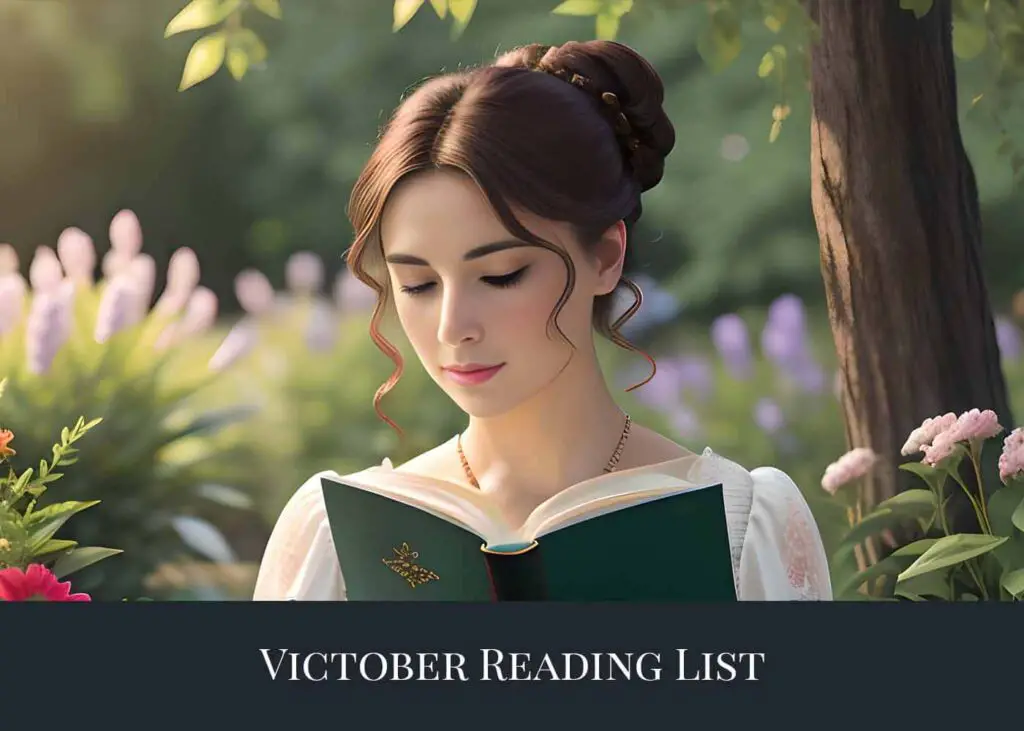
The Definitive Victober Reading List
In the enchanting realm of literary enthusiasts and history buffs, there exists a captivating phenomenon known as Victober, short for “Victorian October.” As the leaves begin to fall and the air turns crisp, bibliophiles around the world come together to celebrate this unique event. Victober is not just a mere month on the calendar; it’s a vibrant tribute to the rich and illustrious Victorian era, a period of profound transformation and unparalleled literary brilliance.
These seismic social changes found their voice in the literature of the time, with authors and poets capturing the nuances of a rapidly evolving society. From Charles Dickens’ vivid depictions of the stark realities of urban life in “Oliver Twist” to Thomas Hardy’s exploration of rural decline in “Tess of the d’Urbervilles,” literature played a pivotal role in reflecting and shaping Victorian society. The Victorian Era was a crucible of ideas, where authors navigated the shifting tides of progress and tradition, leaving an enduring literary legacy that continues to captivate readers today. In this blog post, we embark on a journey through the labyrinthine alleys of Victober, exploring its popularity and the enduring charm of the Victorian literary tradition.
1. Victober Reading List
Here is a comprehensive list of some notable authors and books from the Victorian era:
1.1. Charles Dickens
Charles Dickens (1812-1870), the renowned 19th-century English novelist, is celebrated for his vivid characters, social commentary, and timeless storytelling.
Great Expectations (1861) – In this classic coming-of-age tale, the young orphan Pip navigates the complexities of class, love, and self-discovery against the backdrop of Victorian England.
A Tale of Two Cities (1859) – Set during the tumultuous times of the French Revolution, this novel explores the parallel destinies of two cities, London and Paris, and the enduring power of love and sacrifice.
Oliver Twist (1837) – Follow the adventures of the innocent orphan Oliver Twist as he confronts the harsh realities of poverty, crime, and corruption in 19th-century London.
David Copperfield (1850) – A semi-autobiographical novel that traces the life of the titular character from his troubled childhood to his journey towards self-discovery and adulthood.
Bleak House (1853) – A masterful portrayal of the intricacies of the British legal system and the lives it affects, as seen through the eyes of the young Esther Summerson.
A Christmas Carol (1843) – Immerse yourself in the heartwarming and transformative tale of Ebenezer Scrooge, a miserly old man, who learns the true spirit of Christmas through a series of haunting encounters.
Hard Times (1854) – Set in the fictional Coketown, Dickens critiques the dehumanizing effects of industrialization and the pursuit of utilitarianism on the lives of its inhabitants.
1.2. Charlotte Brontë
Charlotte Brontë (1816-1855), the brilliant 19th-century English novelist, is celebrated for her powerful storytelling and vivid characters.
Jane Eyre (1847) – Jane Eyre is Charlotte Brontë’s magnum opus, a Gothic romance that tells the tale of the indomitable Jane Eyre. Orphaned and oppressed, Jane’s journey through hardship and love is a compelling exploration of morality, feminism, and the human spirit.
Shirley (1849) – Set against the backdrop of the industrial unrest of the 19th century, Shirley delves into the struggles of the working class and the challenges faced by women in a male-dominated society.
Villette (1853) – Villette is a haunting and introspective novel that follows the journey of Lucy Snowe, a young Englishwoman who seeks solace and self-discovery in the fictional town of Villette, Belgium. Brontë’s exploration of isolation and personal transformation is both poignant and mesmerizing.
1.3. Emily Brontë
Emily Brontë (1818-1848), the enigmatic author of the 19th century, is celebrated for her haunting and passionate novel that continue to captivate readers with their raw emotional power and gothic allure.
Wuthering Heights (1847) – Wuthering Heights is Emily Brontë’s magnum opus and a true literary classic. Set in the desolate moors of Yorkshire, the novel follows the tumultuous love story between Catherine Earnshaw and the dark, brooding Heathcliff.
1.4. Anne Brontë
Anne Brontë (1820-1849), the lesser-known sister of the famous Brontë trio, holds a distinct place in literary history for her insightful and socially conscious novels.
Agnes Grey (1847) – Agnes Grey is Anne Brontë’s debut novel and a poignant exploration of the life of a governess in 19th-century England. The eponymous character, Agnes Grey, navigates the challenges of her profession while facing the cruelty of her charges and the indifference of society.
The Tenant of Wildfell Hall (1848) – The novel tells the story of Helen Graham, a woman who flees an abusive marriage to protect her son. Through Helen’s diaries, Anne addresses themes of alcoholism, domestic abuse, and the limitations imposed on women in the 19th century.
1.5. George Eliot
George Eliot (1819-1880), the pen name of Mary Ann Evans, was a prolific English novelist in the 19th century, known for her insightful and complex character studies and her keen understanding of human nature.
Middlemarch (1871) – In Middlemarch, George Eliot masterfully weaves together the lives of the residents of a provincial town, offering a rich tapestry of interconnected stories that explore ambition, love, and societal change.
Silas Marner (1861) – This novel tells the touching story of Silas Marner, a lonely weaver whose life takes a transformative turn when he adopts a young orphaned girl, Eppie.
The Mill on the Floss (1860) – Follow the tumultuous lives of siblings Tom and Maggie Tulliver as they grapple with family expectations, societal constraints, and their deep bond in this poignant novel.
Daniel Deronda (1876) – Set against the backdrop of 19th-century England and the Jewish diaspora, “Daniel Deronda” explores themes of identity, love, and social responsibility through the life of its titular character.
Adam Bede (1859) – A tale of love, betrayal, and redemption, “Adam Bede” is a story that centers around the lives of ordinary people in rural England, brought to life with Eliot’s characteristic empathy.
Romola (1862-63) – Set in Renaissance Italy, “Romola” follows the life of the titular character, a strong-willed woman in a time of political upheaval, as she navigates love, betrayal, and personal growth.
Felix Holt, the Radical (1866) – This novel explores the tensions between social classes and political ideologies in 19th-century England, as seen through the eyes of the idealistic protagonist, Felix Holt.
1.6. Elizabeth Gaskell
Elizabeth Gaskell (1810-1865), a prominent Victorian novelist, is celebrated for her vivid portrayals of 19th-century England, highlighting the social, cultural, and moral intricacies of her time.
North and South (1855) – In “North and South,” Gaskell contrasts the industrial North with the genteel South as Margaret Hale navigates her way through class tensions and personal growth in a changing world.*
Cranford (1851) – Set in the fictional town of Cranford, this charming novel humorously explores the lives of the town’s eccentric residents, offering a delightful and heartwarming glimpse into a close-knit community.
Wives and Daughters (1864-66) – Follow the coming-of-age journey of Molly Gibson as she encounters love, family secrets, and societal expectations in this unfinished yet brilliantly crafted novel.
Mary Barton (1848) – A tale of love, labor strife, and social injustice, Mary Barton provides a vivid depiction of the hardships faced by factory workers in Victorian Manchester.
Ruth (1853) – Gaskell’s Ruth tells the story of a young woman who faces societal condemnation for a perceived moral transgression, exploring themes of forgiveness and redemption.*
Cousin Phillis (1864) – In this novella, Gaskell explores the impact of industrialization on rural life and the complexities of human relationships through the eyes of the protagonist, Paul Manning.
Sylvia’s Lovers (1863) – A gripping tale of love and loss set against the backdrop of the Napoleonic Wars, “Sylvia’s Lovers” delves into the lives of Sylvia Robson and her two devoted suitors.
1.7. Lewis Carroll
Lewis Carroll (1832-1898), the pen name of Charles Lutwidge Dodgson, is best known for his whimsical and imaginative tales that have captivated readers of all ages for generations. His books are a delightful blend of fantasy, wordplay, and creativity. If you’re eager to explore the enchanting world of Lewis Carroll, here are some recommended books with concise descriptions:
Alice’s Adventures in Wonderland (1865) – Follow young Alice as she tumbles down a rabbit hole into a surreal world filled with eccentric characters, whimsical creatures, and absurdity.
Through the Looking-Glass, and What Alice Found There (1871) – In this sequel to Alice’s Adventures in Wonderland, Alice steps through a looking-glass into a parallel world where chess pieces come to life, and the rules of reality are ever-changing.
1.8. Wilkie Collins
Wilkie Collins (1824-1889), a 19th-century English novelist, was a pioneer of the mystery and detective genres.
The Woman in White (1859) – This novel introduces readers to a mysterious woman dressed in white, a sinister conspiracy, and the courageous individuals determined to uncover the truth.
The Moonstone (1868) – Considered one of the earliest detective novels, “The Moonstone” revolves around the theft of a valuable gemstone and the quest to solve the enigmatic crime.
Armadale (1864) – A tale of deception and identity, “Armadale” explores the consequences of a secret that haunts the lives of its characters, Allan Armadale and Ozias Midwinter.
No Name (1862) – In “No Name,” Collins examines themes of inheritance, identity, and revenge as two sisters fight to claim their rightful place in society.
Basil (1852) – This novel delves into the destructive power of jealousy and obsession as the protagonist, Basil, becomes entangled in a tumultuous love affair.
1.9. Oscar Wilde
Oscar Wilde (1854-1900), the celebrated Irish playwright, poet, and author, is renowned for his sharp wit, social commentary, and enduring literary works.
The Picture of Dorian Gray (1890) – In this Gothic novel, Wilde explores the consequences of a Faustian bargain as the portrait of the young and handsome Dorian Gray bears the scars of his immoral life.
The Importance of Being Earnest (1895) – Wilde’s masterpiece of comedic brilliance, this play satirizes the absurdities of Victorian society through the hilarious misadventures of characters leading double lives.
Lady Windermere’s Fan (1892) – A comedy of manners, this play explores the consequences of rumors, societal expectations, and the complexities of marital fidelity.
Salomé (1893) – Originally written in French, Salomé is a symbolist play that retells the biblical story of Salome and her seductive dance, with lush and decadent prose.
The Happy Prince and Other Tales (1888) – A collection of charming and moralistic fairy tales, featuring characters like the selfless Happy Prince and the devoted Nightingale.
1.10. Thomas Hardy
Thomas Hardy (1840-1928), the esteemed English novelist and poet, is celebrated for his evocative portrayals of rural life, complex characters, and profound themes. If you’re looking to immerse yourself in the world of Hardy, here are some recommended books with concise descriptions:
Tess of the d’Urbervilles (1891) – Follow the tragic fate of Tess Durbeyfield, a young woman whose life is marred by social prejudice and personal misfortune.
Far from the Madding Crowd (1874) – Set in the idyllic English countryside, this novel explores the romantic entanglements of Bathsheba Everdene and the three very different men who court her.
The Mayor of Casterbridge (1886) – Witness the rise and fall of Michael Henchard, a man whose impulsive actions shape his destiny in the town of Casterbridge.
Jude the Obscure (1895) – This novel tells the story of Jude Fawley and Sue Bridehead, two star-crossed lovers struggling to escape societal constraints and pursue their dreams.
The Return of the Native (1878) – Set on the desolate Egdon Heath, this novel explores themes of fate and destiny through the lives of its complex characters.
Under the Greenwood Tree (1872) – A charming pastoral novel that offers a lighthearted glimpse into the lives of the village musicians and the changing times in rural England.
The Woodlanders (1887) – This tale explores love and the clash between tradition and progress in the lives of the inhabitants of Little Hintock.
1.11. Bram Stoker
Bram Stoker (1847-1912), the Irish author best known for his iconic novel “Dracula,” was a master of Gothic horror and supernatural fiction.
Dracula (1897) – Stoker’s magnum opus, “Dracula,” introduces the iconic vampire Count Dracula and follows the relentless pursuit to vanquish him by a group of courageous individuals.
1.12. Other Victorian Authors
Here are other Victorian authors who offer a diverse array of literary experiences that you can explore: Anthony Trollope, George Meredith, Samuel Butler, Anthony Hope, George MacDonald, Margaret Oliphant, Dinah Craik, Charlotte Riddell, Rhoda Broughton, Charlotte M. Yonge, R.D. Blackmore and H.enry Wood.
Conclusion
Victober is an enchanting literary challenge that invites you to step back in time and explore the world of Victorian literature. Whether you’re captivated by the societal commentaries, mesmerized by the romances, or intrigued by the mysteries, there’s a Victorian novel waiting to transport you to another time and place. To fully immerse yourself in Victober, engage with fellow participants on social media platforms like YouTube, Instagram, Twitter, and Goodreads. Share your progress, thoughts on the books you’re reading, and any insights you gain along the way.




